![]()
![]()
![]()
Use LEFT and RIGHT arrow keys to navigate between flashcards;
Use UP and DOWN arrow keys to flip the card;
H to show hint;
A reads text to speech;
52 Cards in this Set
- Front
- Back
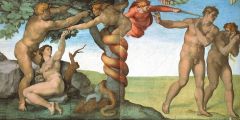
|
Temptation and Expulsion of Adam and Eve 1508-12 Michelangelo fresco in Sistine Chapel religious narrative;muscled, fleshy, naked bodies |
|

|
Last Supper painting 1498 Da Vinci fresco; kind of flat; sad characters, religious, gestural, color scheme, no use of light source;painted on dry plaster |
|
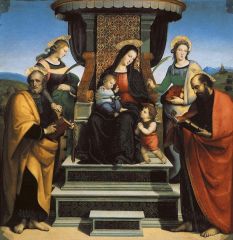
|
(Madonna and) Child Enthroned with Saints; 1505 Raphael painting; bright bold colors; strong light; dark dress; strong focal point;smart Jesus but looks like a baby, maternal looking Mary; oil and tempera; not really a biblical momentbut a biblical story with biblical characters; calm and quiet moment, not sador active; gazes bring viewers in/include us |
|
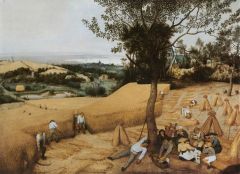
|
The Harvesters painting 1565 Peter Bruegel the Elder (Netherlandish) slice of life;secular; city, peasants; realism; narrative; recording of history; rearranging life to fit in the picture, inspiration from real surroundings; canvas used up, space filled in by parts of narration ( but not busy); oil on wood(not yet canvas); secular; realistic; compassion for working class; realism |
|
|
Baroque in Netherlands Netherlandish artists |
lots of genre painting; depiction of everyday spiritualism; rich merchants commissioned works for their homes Rembrandt, Bruegel, Vermeer, Van Eyck, van der Weyden, Rubens, |
|

|
School of Athens 1509-11 by Racphael (ITA) stage-like setup; busy, theatrical; narrative biblical scene; bold colors; incorporation ofarchitecture and art; vanishing point perspective |
|

|
Madonna and Child 1240 Berlinghiero (ITA) Mary gesturing to Jesus/salvation; Jesus looks like a grownup; Mary is sad; black red and gold; gold background; tempera on wood (commonfor icons); aspects of timelessness (gold background); Byzantine influences;philosophical Jesus presenting himself as the way; flat, stylized drapery;similar to late Romanesque drapery, no depth; non naturalistic still, butcloser; towards art of gesture and gazes |
|
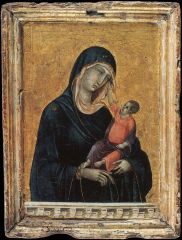
|
Madonna and Child 1278?;1295-1300 Duccio (ITA) Gothic Jesus looking up at Mary, lifting her veil away; Jesus tiny adult; Mary in black, less expressive but still somber; gold background; halos;more affectionate Mary Jesus relationship; less worried Mary; tempera and goldon wood; no gesturing to salvation; mother son intimacy, gazing at each other;no longer abstract mom son relation |
|
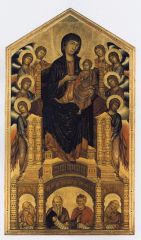
|
Madonna Enthroned (Santa Trinita Madonna) 1280-1290 Cimabue (ITA) Gothic style lots of gold, Mary in black, gesturing to jesus, saintsall around, elaborate thrown, religious, red gold and black |
|
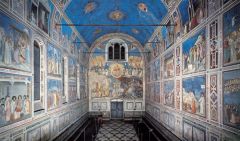
|
Frescos in the Arena Chapel 1305 Giotto Gothic arena chapel time in which frescos popularized as did personal spirituality |
|
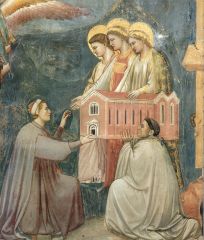
|
Last Judgement painting 1305 Giotto Gothic style flat figures; gold for religious figures; lighter than the Epiphany, blues andgreens detail of donor painted with model of church |
|
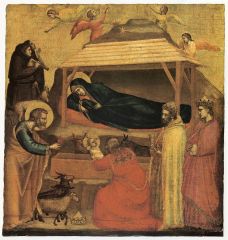
|
Ephiphany 1320 Giotto Gothic lots of gold, Mary dressed in black, red andgold and brown; gestural; flat figures; figure in front with back to useincludes viewers in the scene; other figure looking out at us, some looking atjesus, others look at angels or us; AKA Adoration of the Magi; Florence;1266-1337?; use of light and shadow to provide sense of figurine massiveness;more humanistic/natural; Jesus looks more like an actual baby rather than atiny philosopher; continuous narration; tempera on wood; changed the game interms of space/composition; gold background = timelessness, but still a morenaturalistic setting |
|
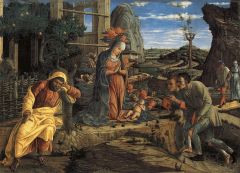
|
Adoration of the Shepherds 1450-57 Mantegna (ITA) triangularset up; elaborate background landscape and setting; Jesus as a baby, not tinyadult; inclusion of religious figures and normal people; spatial setupimportant; realistic baby; increased naturalism (new development); Mary not toworried/scared/sad; real and unattractive shepherds; social commentary showingthe poor paying respect to Jesus, clear receding space, crisp background, onepoint vanishing/linear perspective; layered depth in back, fore, and middleground"` |
|
|
Mona Lisa |
Da Vinci 1503 |
|
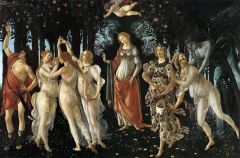
|
Primavera painting 1482 Botticelli Florence airy, storybook like;narrative; groups of action; mythicl, secular; nature |
|
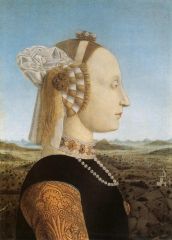
|
Portaitof Battista Sforza painting; 1472-76 Piero della Francesca profile figure; shows her in front of alandscape; jewels and clothes show wealth |
|
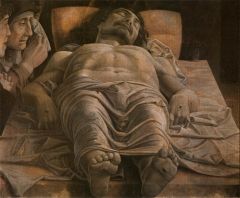
|
Lamentationof the Dead Christ 1490 Mantegna viewer at foot of bed; strangeview/perspective; expressive; dark; realistic |
|
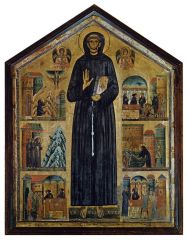
|
StFrancis Altarpiece 1235 Berlinghieri Gothic style; flat, dark, of use of space, multiplenarratives going on |
|
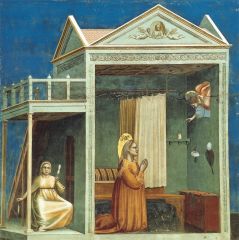
|
Annunciationto St Anne 1305 Giotto Gothic style; flat, narrative, divided byspace/scenes, red and blue color scheme |
|

|
Ognissanti Madonna
1310 Giotto Gothic; Maryin black enthroned, holding Jesus; very similar scheme and setup to Raphael’sChild Enthroned with saints, but different mary-jesus relationship: Giotto’sshow distance between mother and son, jesus as grown up and all knowing, maryserving a purpose whereas Raphael’s mary is maternal and jesus is an actualbaby; highlights change in (use of) space; heaviness to drapery; sense of mass;use of light to create 3D modeling |
|
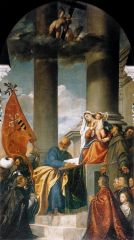
|
PesaroMadonna painting
1519 Titian (ITA) Venice; strange use of space; baby Jesus; young Mary;strong colors; theatrical |
|

|
Last Judgment 1425-30 Van Eyck painting; threetiers/narratives/scenes, stacked; heaven is large, earth in middle is small,underworld at bottom is large; oil on canvas; similar to what would be on analtar piece; very detailed; weird POV; some atmospheric perspective; tries toake depicted figures look old fashioned/historicalhighlig4H% |
|
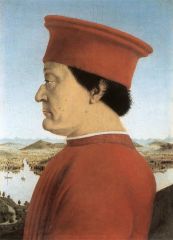
|
Portraitof Federico da Montefeltro 1472 Piero della Francesca painting; exact profile; landscapebackground; subject in center; plainly dressed; accentuated facial features |
|
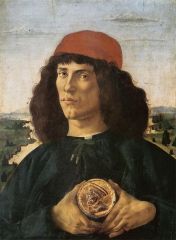
|
Portraitof a Man Holding a Medal of Cosmo de Medici 1474-75 Botticelli Florence |
|
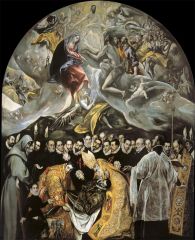
|
Burial of Count of Orgaz 1586-88 El Greco Toledo,Spain two scenes, upper and lower (heaven above, reality below);heaven depicted as lighter, flowy-er, Marystill in dark colors, sad people;Earth all dark colors; somber; death; space filled inq |
|
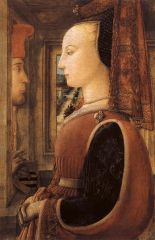
|
Portrait of a Man and Woman at a Casement early 1440s Fra Filippo Lippi (ITA) double portrait; both subjects in profile; woman looking out of window,closer to viewer, centered, forefront, rich, elaborate; man additional, lookingin window; elaborate setting/background; secular; tempera on wood at Met |
|
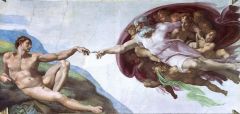
|
Creationof Adam 1508-1512 Michelangelo fresco lots of movement; Adam relaxed, serene, receiving, ideal,detailed; God large, theatrical, hurried, important |
|
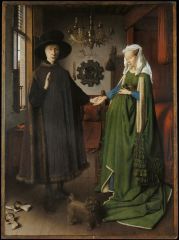
|
GiovanniArnolfini and his Wife 1434 Van Eyck dark colors; not totally realistic; lotsof detail; heavy, sober tones; indoor; mirror reflecting the painter;creative/playful |
|
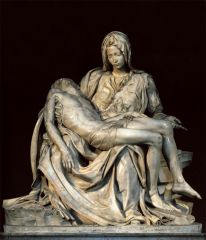
|
Pietasculpture 1499 Michelangelo Rome; Mary with dead adult, not-baby Jesus across her lap; sadbut serene, young Mary, not maternal; flowing, folded fabrics; air ofnonchalance; serenity; realistic bodies |
|
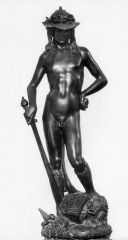
|
David with Head of Goliath 1420s-1460s Donatello Florence bronze?; David standing on Goliath’s head with sword, nonchalantpose, not idealistic body, almost small and teenager-like; action has happened,not moving44 |
|
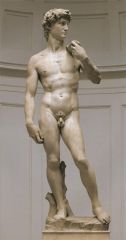
|
David 1501-04 Michelangelo Florence 17 ft high; muscled,detailed, realistic, idealistic, thoughtful, pre-action, contemplative,beautiful |
|

|
Aphrodite of Knidos sculpture by Praxiteles(Greek) 340-330 BCE roman copy after a greek original; relaxed stance;support incorporated to narrative, serene face |
|
|
Gothic art |
started around 1200 evolved from Romanesque more animated figures/expressions figures smaller compared to background scene figures arranged more freely in space frescos and altar paintings |
|
|
Romanesque art |
1000 - 1200 Architecture: apses, rounded arches, barrel vaults Byzantine iconographic figures/subject painted (i.e. Mary and Jesus; Last Judgement scene) Bright, primary colors Compositions had little depth Sculpture subjects: biblical/pictorial |
|
|
Renaissance |
1400 - 1525 Themes: altarpieces, frescos, small works for private devotion balance and proportion; proper sizes Treating the painting as a window into a space (Giotto) |
|
|
Michelangelo |
Italian 1499 Pieta Sculpture (Rome) 1501-4 David (Florence) 1508-12 Sistene Chapel (Temptation and Expulsion; Creation of Adam) |
|
|
Da Vinci |
Italian 1488-98 Last Supper 1503-05 Mona Lisa |
|
|
Raphael |
Italian 1505 Madonna and Child Enthroned w Saints 1510 School of Athens |
|
|
Peter Bruegel the Elder |
Dutch/Netherlandish 1565 The Harvesters 1567 Peasant Wedding |
|
|
Berlinghiero |
Italian 1235 St Francis Altar piece 1240 Madonna and Child |
|
|
Duccio |
Italian 1295 Madonna and Child |
|
|
Cimabue |
Italian 1285 Madonna Enthroned (Santa Trinita Madonna) |
|
|
Giotto |
Italian 1305 Frescos in the Arena Chapel 1305 Last Judgement painting 1305 Annunciation of St Anne 1305 Lamentation 1310 Ognissanti Madonna 1320 Epiphany painting |
|
|
Mantegna |
Italian 1450 Adoration of the Shepherds 1470 Oculus |
|
|
Botticelli |
Italian 1474 Portrait of a Man holding Medal of Cosimo 1482 Primavera 1505 Three Miracles of St Zenobius |
|
|
Piero della Francesca |
Italian 1470 Portraits 1490 Lamentation of the Dead Christ |
|
|
Titian |
Italian/Venitian 1519 Pesaro Madonna known for color |
|
|
Van Eyck |
Dutch/Netherlandish 1425-30 Last Judgement 1434 Arnolfini and his Wife |
|
|
El Greco |
Greek mannerist 1570 Christ Healing the Blind 1586 Burial of Count of Orgaz 1595-1600 View of Toledo 1600 portrait of Cardinal Fernando 1600 Adoration of the Shepherd |
|
|
Mannerism |
1520 - 1580 High end of Renaissance turned into Baroque at end of 1500s early on: elongated forms, theatrical setting/lighting, collapsed perpsective later: art imitating art; Michelangeloian |
|
|
Donatello |
Italian 1450 David with head of Goliath sculpture |
|
|
Fra Lippi |
Italian 1440 Portrait of A Man and Woman at a Casement |

